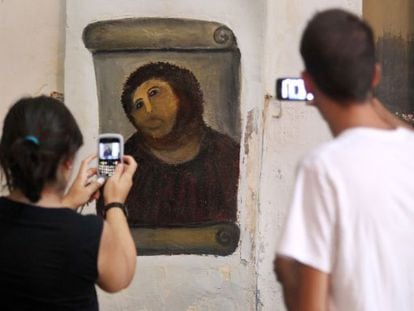Spain’s latest ‘Ecce Homo’: how a botched restoration made global headlines
What was once the face of a shepherdess has been completely disfigured by sloppy workmanship, with the figure now drawing comparisons to Donald Trump

Several days ago, the Spanish painter Antonio Capel was chatting with the owners of Vivaldi, a florist’s shop in the northern city of Palencia, when they remarked that something was amiss with the façade of a historic building that now houses a branch of the Unicaja bank. Capel was surprised so they suggested he take a look at what was once the delicate face of a shepherdess.
The artist went up to his studio and, using his camera’s zoom, saw that the familiar features were now nothing short of an eyesore. The statue’s eyes were in the wrong place and her nose and mouth had been clumsily crafted. As Capel jokes, whoever was responsible for the restoration was no fine artist – an observation backed by the Spanish Association of Conservators and Restorer’s rapid clarification that it was not a professional job. The botched restoration has already drawn comparisons to the infamous Ecce Homo painting which was disfigured beyond recognition by an amateur artist in Borja in 2012.

The florists in Palencia, who preferred to remain anonymous, recall that heavy rains several years back caused a fall of debris from the building, which was inaugurated in 1923. They later realized that the face of the shepherdess was missing. “The strange thing is that no one noticed” how badly it had been restored, they say.
Capal, meanwhile, says it is beyond his comprehension that such slapdash workmanship should be allowed on such a beautiful building, which is located in the heart of the city on Mayor street. In his opinion, the workers simply used a tracing technique to fashion the face out of plaster in the hope that it would be too high up for anyone to notice.
Unicaja denies any responsibility for the sloppy result. Spokespeople from the bank insist that they only own the premises of the branch office and the second floor. Years ago, Caja Duero, which later became part of Unicaja, owned the entire building. However, they sold the upper floors during the takeover to private homeowners. The spokespeople maintain that the building’s administrator informed the homeowners in 2017 that pieces from the façade had fallen off, including the face of the shepherdess. Palencia City Council confirms that they called on the owners to repair the damage that could pose a threat to public safety. They explain the building is under “structural, not integral protection," meaning that any restoration work must protect the structure of the building, but no special consideration needs to be given to its exterior decorations.
Unicaja’s staff laugh when asked about the ham-handed job. Like other botched restorations in Spain, including the cartoonish facelift of a 16th-century sculpture of Saint George in Navarre, the changes went unnoticed until someone with a keen eye spotted them. Even the journalists at the Cadena Ser radio network, which has its newsroom in the building, admit to being oblivious.
But now Spain’s latest Ecce Homo is making international headlines, with even with the British newspaper, The Guardian, flagging up the statue’s perceived resemblance to the incumbent president of the United States, Donald Trump.
English version by Heather Galloway.













































